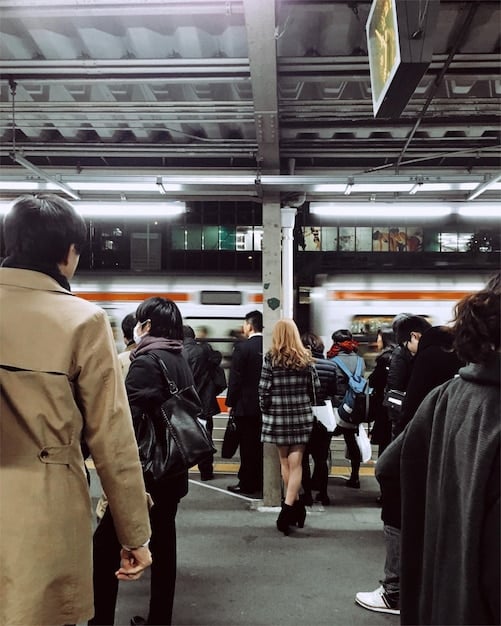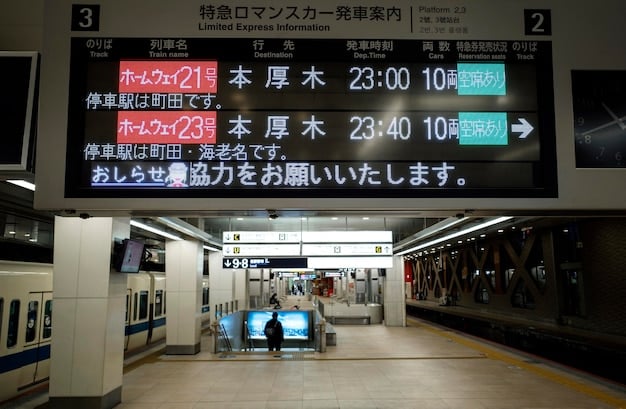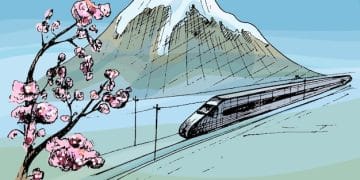Mastering Japan’s Public Transportation: A Comprehensive Guide for US Visitors

Mastering Japan’s public transportation is essential for US visitors, offering an efficient, punctual, and extensive network that, while potentially daunting at first, becomes a smooth and cost-effective way to explore the country with the right preparation and guidance.
Navigating Japan’s public transport system can seem overwhelming for first-time visitors from the US. However, with a little preparation, mastering Japan’s public transportation opens up a world of efficient and affordable travel across this fascinating country.
Understanding the Basics of Japanese Public Transportation
Japan boasts an incredible public transportation network known for its efficiency, punctuality, and cleanliness. However, it differs significantly from what most US visitors are used to. Understanding these differences is the first step to a smooth travel experience.
Types of Transportation Available
Japan offers a wide array of public transport options, from the famous Shinkansen (bullet train) to local trains and buses. Each serves a distinct purpose and caters to different travel needs.
- Shinkansen (Bullet Train): Ideal for long-distance travel, connecting major cities with incredible speed and comfort.
- Local Trains: Perfect for navigating within cities and reaching smaller towns. These are often operated by different companies, each with its own ticketing system.
- Subways: Major cities like Tokyo and Osaka have extensive subway networks, making it easy to get around urban areas quickly.
- Buses: While less commonly used by tourists, buses are available in many cities and rural areas, offering access to places not served by trains.
Key Differences from US Systems
US transportation systems often rely heavily on personal vehicles, leading to less developed public transit. In contrast, Japan’s system is highly integrated and comprehensive, but this can make it seem complex to newcomers.
One significant difference is the emphasis on punctuality. Trains and buses run on strict schedules, often down to the minute. Another key difference is the ticketing system, which can vary depending on the operator and type of transport.

Understanding these foundational aspects will allow you to better navigate the nuances of Japan’s public transport as your trip unfolds, unlocking seamless exploration!
Purchasing Tickets and Passes
Navigating the ticketing system can be daunting for first-time visitors. However, with a little planning, purchasing tickets and passes becomes straightforward. Choosing the right option can also save you a significant amount of money.
Individual Tickets vs. Passes
Depending on your travel plans, you can opt for individual tickets or purchase a travel pass. Individual tickets are suitable for short trips or infrequent use, while passes offer unlimited travel within a specified period or area.
Japan Rail Pass: Is It Worth It?
The Japan Rail Pass is a popular option for tourists, offering unlimited travel on most JR (Japan Railways) trains, including the Shinkansen. However, it’s crucial to evaluate whether it’s cost-effective for your itinerary.
To determine if the Japan Rail Pass is worth it, calculate the cost of individual tickets for your planned Shinkansen journeys. If the total cost exceeds the price of the pass, then it’s likely a good investment. Keep in mind that the pass is valid for a specific duration (e.g., 7, 14, or 21 days), so plan your travels accordingly.
Other Regional and City Passes
Besides the Japan Rail Pass, various regional and city passes are available, offering unlimited travel within specific areas. These passes can be more cost-effective if you plan to focus your travels on a particular region.
- Tokyo Subway Ticket: Offers unlimited travel on all Tokyo Metro and Toei Subway lines.
- Kansai Thru Pass: Provides unlimited travel on subways, trains, and buses in the Kansai region (Osaka, Kyoto, Nara, Kobe).
- Hokkaido Rail Pass: Allows unlimited travel on JR trains throughout Hokkaido.
Exploring these alternatives tailor-made for more constrained areas of travel, helps facilitate budget savings.
Navigating Train Stations
Japanese train stations can be large and complex, especially in major cities. However, they are well-organized and equipped with clear signage in both Japanese and English, making navigation relatively easy.

Understanding Signage and Announcements
Signage in train stations is generally bilingual, with Japanese and English translations. Pay attention to platform numbers, train destinations, and departure times. Announcements are typically made in Japanese, followed by English.
Many stations also have digital displays showing train schedules and real-time updates. These displays often use color-coding to indicate different types of trains (e.g., local, rapid, express).
Using Hyperdia and Other Navigation Tools
Hyperdia is an essential tool for planning your train journeys in Japan. This website and app allow you to search for train routes, check timetables, and calculate fares. It also provides information on platform numbers and transfer locations.
Other useful navigation tools include Google Maps and Japan Travel by NAVITIME. These apps offer similar features to Hyperdia, with the added benefit of offline access.
Using a digital tool like Hyperdia or Google Maps to chart your route and interpret station signage, will give you confidence as you make your way.
Etiquette and Customs on Public Transport
Japanese culture places a strong emphasis on politeness and consideration for others, and this extends to public transport. Following basic etiquette rules will ensure a pleasant experience for everyone.
Silence and Phone Use
One of the most important rules of etiquette is to keep quiet on trains and buses. Avoid talking loudly, and refrain from making phone calls unless it’s an emergency. If you must use your phone, set it to silent mode and use headphones for audio.
Eating and Drinking
Eating and drinking are generally acceptable on long-distance trains like the Shinkansen, but it’s considered impolite to eat or drink on local trains or buses, especially during peak hours.
Giving Up Your Seat
It’s customary to offer your seat to elderly people, pregnant women, or people with disabilities. Priority seating is usually designated near the doors of trains and buses.
By following these guidelines when travelling, you can navigate interactions with others without causing offense. This shows respect for local customs, as well as builds a generally cooperative atmosphere for all parties involved.
Staying Connected: Wi-Fi and Mobile Data
Staying connected is essential for many travelers, whether it’s for navigation, communication, or entertainment. Fortunately, Japan offers several options for accessing Wi-Fi and mobile data.
Free Wi-Fi Hotspots
Many train stations, cafes, and public spaces offer free Wi-Fi hotspots. However, these networks may require registration, and the connection speed can vary. It’s a good idea to download offline maps and translation apps as a backup.
Pocket Wi-Fi vs. SIM Card
For reliable and consistent internet access, consider renting a pocket Wi-Fi device or purchasing a local SIM card. Pocket Wi-Fi devices provide a portable Wi-Fi hotspot that can be shared among multiple devices.
SIM cards offer mobile data access through your smartphone. This can be a more cost-effective option if you only need internet access for one device. Be sure to check that your phone is unlocked and compatible with Japanese SIM cards.
Having a solid connection provides you with flexibility throughout your explorations, from mapping the next leg of your journey to staying in touch with family back home.
Handling Luggage and Accessibility
Traveling with luggage can be challenging, especially during peak hours. Understanding luggage storage options and accessibility features will make your journey much smoother. With consideration, the system can be utilized easily.
Luggage Storage Options
Most train stations offer coin lockers where you can store your luggage. These lockers come in various sizes to accommodate different types of bags. However, larger lockers can be in high demand, so it’s a good idea to arrive early or consider alternative storage options.
Some hotels offer luggage storage services even if you’re not a guest. This can be a convenient option if you want to explore a city before checking in or after checking out.
Accessibility Features for Passengers with Disabilities
Japan is committed to providing accessible public transportation for passengers with disabilities. Many train stations and buses are equipped with ramps, elevators, and tactile paving for visually impaired passengers.
Priority seating is available on trains and buses for elderly people, pregnant women, and people with disabilities. Station staff are also trained to provide assistance to passengers who need it.
With an understanding of these options and the knowledge of the station, the traveler can be proactive about his choices. No matter the circumstances, a little bit of research helps facilitate a smooth expedition.
| Key Point | Brief Description |
|---|---|
| 🚄 Shinkansen | Bullet trains for fast, long-distance travel between major cities. |
| 🎫 Japan Rail Pass | Unlimited travel on most JR trains; evaluate if it’s cost-effective. |
| 📱 Hyperdia App | Essential for planning routes, checking schedules, and calculating fares. |
| 🤫 Etiquette | Silence on trains, avoid phone calls, and offer seats to those in need. |
Frequently Asked Questions
▼
You can purchase the Japan Rail Pass online through an authorized vendor before your trip. Once you arrive in Japan, you will need to exchange your voucher for the actual pass at a JR office.
▼
It’s advisable to book Shinkansen tickets in advance, especially during peak travel seasons. You can reserve your seats up to one month before your travel date.
▼
While major credit cards are increasingly accepted, it’s still a good idea to carry some cash. Many local trains and buses may only accept cash or IC cards.
▼
An IC card is a rechargeable contactless smart card that can be used on most trains and buses in Japan. Simply tap the card on the reader at the ticket gate or fare box.
▼
Don’t hesitate to ask a station attendant for help. Most stations have information counters with staff who can assist you in English. Also, look for signs with maps and directions.
Conclusion
Mastering Japan’s public transportation is a rewarding experience that allows you to explore the country efficiently and affordably. By understanding the basics, purchasing the right tickets, and following local etiquette, US visitors can navigate the system with confidence and enjoy a smooth and memorable trip.





